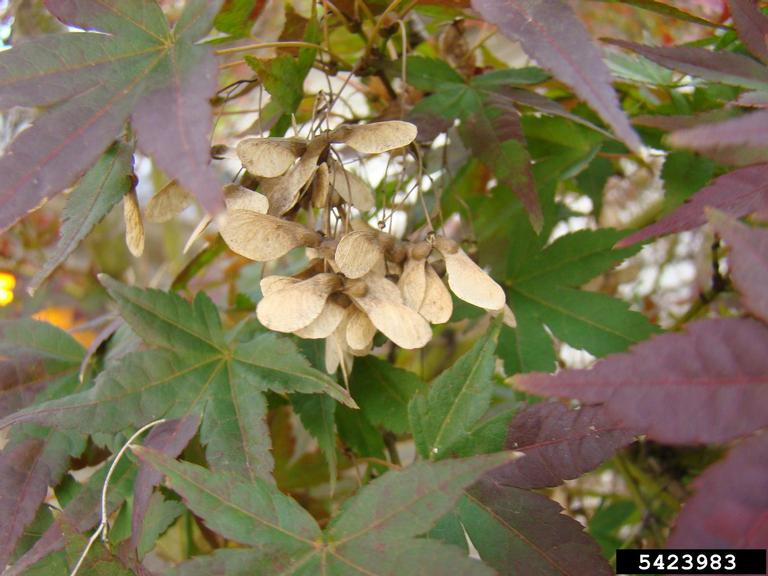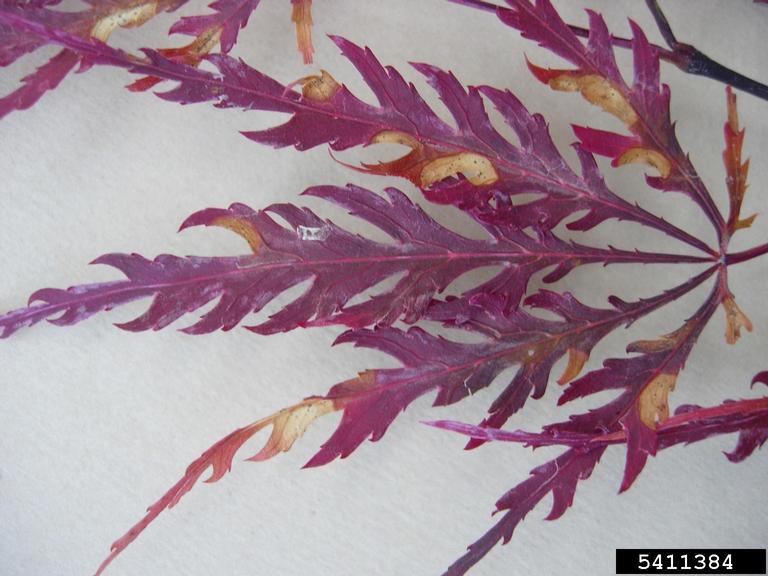Key Takeaways
- Prevention is Key to Disease Management
Most common Japanese maple diseases, from verticillium wilt to leaf spot, can be prevented through proper cultural practices like maintaining good drainage, avoiding bark injury, and practicing garden hygiene. - Environmental Factors Play a Major Role
Many health issues affecting Japanese maples are environmental rather than pathogenic. Proper watering, adequate sunlight, and appropriate soil conditions help prevent most common problems. - Early Intervention Saves Trees
Recognizing disease symptoms early – whether it’s sudden wilting, cankers, or leaf spots – allows for timely treatment. Professional diagnosis helps determine the specific issue and appropriate treatment approach.

Photo credit: Franklin Bonner, USFS (ret.), Bugwood.org
Japanese maples are a beautiful and popular choice for many homeowners. They are a staple in many gardens and landscapes due to their vibrant fall colors and unique foliage. Japanese maples often suffer health issues that are environmental in nature, but they are also susceptible to some common diseases (many of which are shared throughout the Acer genus). Diseases of Japanese maples can cause spots on leaves, wilting, or even death. Luckily, most Japanese maple diseases can be prevented or managed with proper care and maintenance.
Verticillium Wilt
Verticillium wilt is caused by a soil-borne fungus that enters the roots of the plant and blocks the flow of water and nutrients. Symptoms of verticillium wilt include sudden wilting of leaves, yellowing of foliage, and dieback of branches. To prevent this disease, avoid planting Japanese maples in soil that has previously had plants infected with verticillium wilt. Also, practice good garden hygiene by removing any infected plant material immediately.
Cankers
Cankers are caused by various fungi which typically enter a tree through wounded or otherwise compromised bark. Symptoms of cankers include sunken areas on the bark, withered leaves, and dead branches. To prevent canker, avoid injuring the bark of the Japanese maple during pruning or other garden activities. Never girdle the trunk, drill a hole, or hang anything from the branches of your Japanese maple tree. Also, make sure to keep the soil around the tree moist but not waterlogged.
Anthracnose
Occasionally, we see the fungal infection anthracnose on Japanese Maples. Just like with other members of the Acer genus, this fungus attacks the leaves of Japanese Maple trees, causing brown or black spots on the leaves, which can eventually cause them to fall off. Prevention is the best strategy for these trees. To prevent anthracnose, make sure that your Japanese maple has adequate drainage and avoid overhead watering.
Phyllosticta Leaf Spot

Photo credit: Elizabeth Bush, Virginia Polytechnic Institute and State University, Bugwood.org
Phyllosticta Leaf Spot is a fungal disease that sometimes affects Japanese maples. Symptoms include small, circular brown or black spots on the leaves. To prevent this disease, practice good garden hygiene by removing any fallen leaves from around the Japanese maple. Also, make sure that the tree is watered properly and that it receives enough sunlight.
Japanese maples are a beautiful addition to any garden, but they are susceptible to diseases like any other tree. It is important to take precautions to prevent these diseases from occurring.
Get professional diagnosis and recommendations for your Japanese Maple diseases:


